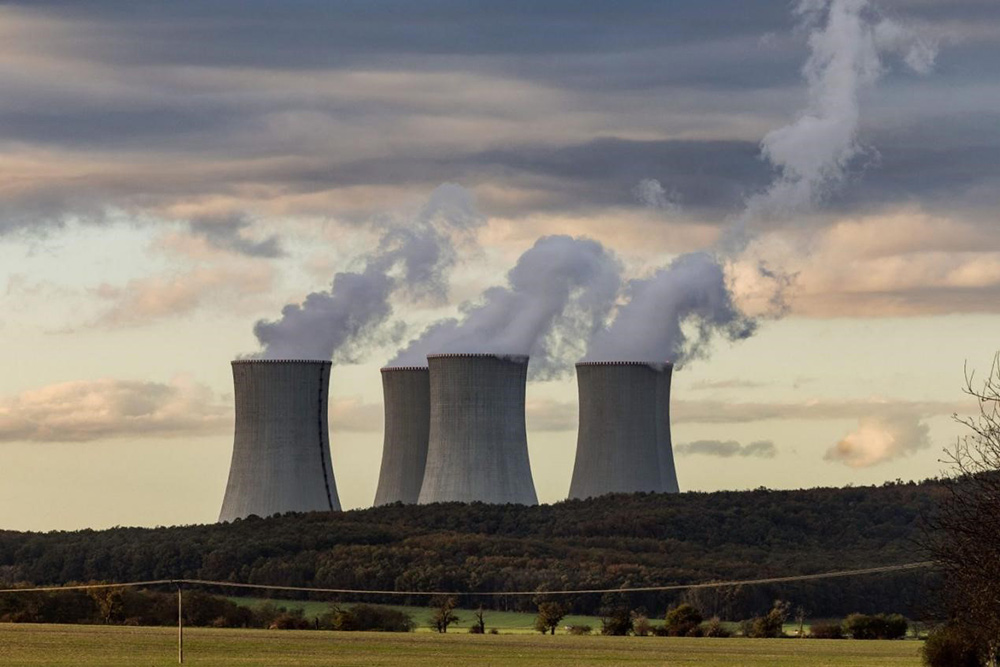 2023年11月,位于斯洛伐克莫霍夫采的莫霍夫采核電廠。圖片來(lái)源:JANOS KUMMER—GETTY IMAGES
2023年11月,位于斯洛伐克莫霍夫采的莫霍夫采核電廠。圖片來(lái)源:JANOS KUMMER—GETTY IMAGES在美國(guó)及其盟國(guó),廢棄鈾礦的所有者正在重啟運(yùn)營(yíng),以利用核燃料需求增長(zhǎng)帶來(lái)的機(jī)遇。
至少有五家美國(guó)生產(chǎn)商正在懷俄明州、得克薩斯州、亞利桑那州和猶他州等州重啟礦場(chǎng)。此前,這些州的鈾礦生產(chǎn)一度繁榮,直到各國(guó)政府在2011年日本福島核災(zāi)難后對(duì)這種放射性元素感到不滿。
福島核事故發(fā)生后,鈾價(jià)暴跌,德國(guó)和日本等國(guó)啟動(dòng)了逐步淘汰核反應(yīng)堆的計(jì)劃,大多數(shù)美國(guó)礦場(chǎng)因此閑置。
如今,隨著各國(guó)政府轉(zhuǎn)向核電以實(shí)現(xiàn)減排目標(biāo),而主要鈾生產(chǎn)商難以滿足需求,這種銀白色金屬的價(jià)格正在飆升。這為曾經(jīng)無(wú)利可圖的鈾礦運(yùn)營(yíng)提供了填補(bǔ)供應(yīng)缺口的機(jī)會(huì)。
六十多年來(lái),鈾一直被用作能源,為核電站和反應(yīng)堆提供燃料。全球約三分之二的產(chǎn)量來(lái)自哈薩克斯坦、加拿大和澳大利亞。
今年3月初,數(shù)千名礦業(yè)高管、地質(zhì)學(xué)家和銀行家齊聚多倫多,參加加拿大勘探與開(kāi)發(fā)者協(xié)會(huì)(Prospectors & Developers Association of Canada)的會(huì)議,鈾將成為熱議話題。這一年度盛會(huì)吸引了至少10家鈾公司參加,包括Denison Mines Corp.、Fission Uranium Corp.和IsoEnergy Ltd.。
由于越來(lái)越多的國(guó)家考慮利用核能應(yīng)對(duì)氣候變化,對(duì)鈾的需求預(yù)計(jì)將飆升。國(guó)際原子能機(jī)構(gòu)(International Atomic Energy Agency)估計(jì),到2040年,全球每年將需要超過(guò)10萬(wàn)噸鈾,這需要把當(dāng)前的開(kāi)采和加工量增加近一倍。
加起來(lái)占全球供應(yīng)量一半的加拿大Cameco Corp.和哈薩克斯坦的國(guó)家原子能工業(yè)公司(Kazatomprom)一直在努力提高產(chǎn)量。這兩家公司警告稱,由于運(yùn)營(yíng)問(wèn)題,未來(lái)幾年的鈾產(chǎn)量將低于預(yù)期。
總部位于美國(guó)得克薩斯州的Uranium Energy Corp.的執(zhí)行副總裁斯科特·梅爾比說(shuō):“我們正處于明顯的供應(yīng)緊張局面,這在過(guò)去也一直存在。隨著新反應(yīng)堆的投入使用,需求再次增加。”
梅爾比指出,由于多年來(lái)在采礦和勘探方面的投資不足,產(chǎn)量未能跟上需求。他所在的公司正在重啟懷俄明州和德克薩斯州2018年閑置的礦場(chǎng)。
Energy Fuels Inc.于2023年年底在亞利桑那州、猶他州和科羅拉多州重啟運(yùn)營(yíng)計(jì)劃,而Uranium Energy Corp.則表示將重啟懷俄明州的一座閑置礦場(chǎng)。澳大利亞和加拿大的中型企業(yè)也宣布了類(lèi)似的計(jì)劃。
毋庸置疑的是,這些礦場(chǎng)的產(chǎn)量——大多數(shù)都是小型且接近壽命末期的——將僅占全球鈾供應(yīng)的一小部分。
斯普羅特資產(chǎn)管理公司(Sprott Asset Management)的首席執(zhí)行官約翰·錢(qián)帕利亞說(shuō):“業(yè)界顯然正在試圖通過(guò)重啟小型礦場(chǎng)來(lái)應(yīng)對(duì)這一緊張局勢(shì),但當(dāng)一個(gè)礦場(chǎng)停產(chǎn)這么久,這顯然無(wú)法起到實(shí)質(zhì)性作用。”該公司經(jīng)營(yíng)著Sprott Physical Uranium Trust基金。
主要生產(chǎn)商
隨著主要生產(chǎn)商將在價(jià)格低迷時(shí)期留在地下的數(shù)百萬(wàn)磅鈾開(kāi)采出來(lái),供應(yīng)緊張問(wèn)題應(yīng)該會(huì)有所緩解。哈薩克斯坦國(guó)家原子能工業(yè)公司多年來(lái)一直在提高產(chǎn)量,此前該公司的運(yùn)營(yíng)水平遠(yuǎn)低于產(chǎn)能。
Cameco公司旗下全球最大的高品位鈾礦和加工廠位于加拿大西部薩斯喀徹溫省的麥克阿瑟河和基湖。Cameco公司在2018年至2021年由于市場(chǎng)疲軟而停產(chǎn)后,一直在提高產(chǎn)量。
位于英國(guó)倫敦的投資銀行Libereum的資深大宗商品分析師湯姆·普萊斯表示,這兩家巨頭“將非常擔(dān)心自己的市場(chǎng)份額會(huì)被一群后起之秀奪走,因此它們希望奪回市場(chǎng)份額。這將給市場(chǎng)起到極大的降溫效果。”
盡管如此,美國(guó)重啟礦場(chǎng)標(biāo)志著礦業(yè)的復(fù)蘇,畢竟該行業(yè)在五年前幾乎處于消亡邊緣。美國(guó)的鈾產(chǎn)量在2019年創(chuàng)下了17.4萬(wàn)磅的歷史新低,比1980年的4,400萬(wàn)磅峰值有所下降,美國(guó)開(kāi)始愈加依賴從加拿大、澳大利亞、哈薩克斯坦和俄羅斯等國(guó)進(jìn)口鈾。
美國(guó)鈾產(chǎn)業(yè)推動(dòng)產(chǎn)能增加也具有政治意義:在地緣政治不確定的情況下,美國(guó)政府尋求獲得鈾供應(yīng)。俄羅斯在2022年俄烏沖突爆發(fā)后受到制裁,這給從哈薩克斯坦出發(fā)的鈾運(yùn)輸路線帶來(lái)了挑戰(zhàn),原因是哈薩克斯坦的鈾出口通常要經(jīng)過(guò)俄羅斯港口。
美國(guó)鈾生產(chǎn)商(Uranium Producers of America)預(yù)測(cè),為滿足需求,未來(lái)十年美國(guó)將需要8個(gè)到10個(gè)新的大型鈾礦進(jìn)入生產(chǎn)。(財(cái)富中文網(wǎng))
譯者:中慧言-王芳
2023年11月,位于斯洛伐克莫霍夫采的莫霍夫采核電廠。
在美國(guó)及其盟國(guó),廢棄鈾礦的所有者正在重啟運(yùn)營(yíng),以利用核燃料需求增長(zhǎng)帶來(lái)的機(jī)遇。
至少有五家美國(guó)生產(chǎn)商正在懷俄明州、得克薩斯州、亞利桑那州和猶他州等州重啟礦場(chǎng)。此前,這些州的鈾礦生產(chǎn)一度繁榮,直到各國(guó)政府在2011年日本福島核災(zāi)難后對(duì)這種放射性元素感到不滿。
福島核事故發(fā)生后,鈾價(jià)暴跌,德國(guó)和日本等國(guó)啟動(dòng)了逐步淘汰核反應(yīng)堆的計(jì)劃,大多數(shù)美國(guó)礦場(chǎng)因此閑置。
如今,隨著各國(guó)政府轉(zhuǎn)向核電以實(shí)現(xiàn)減排目標(biāo),而主要鈾生產(chǎn)商難以滿足需求,這種銀白色金屬的價(jià)格正在飆升。這為曾經(jīng)無(wú)利可圖的鈾礦運(yùn)營(yíng)提供了填補(bǔ)供應(yīng)缺口的機(jī)會(huì)。
六十多年來(lái),鈾一直被用作能源,為核電站和反應(yīng)堆提供燃料。全球約三分之二的產(chǎn)量來(lái)自哈薩克斯坦、加拿大和澳大利亞。
今年3月初,數(shù)千名礦業(yè)高管、地質(zhì)學(xué)家和銀行家齊聚多倫多,參加加拿大勘探與開(kāi)發(fā)者協(xié)會(huì)(Prospectors & Developers Association of Canada)的會(huì)議,鈾將成為熱議話題。這一年度盛會(huì)吸引了至少10家鈾公司參加,包括Denison Mines Corp.、Fission Uranium Corp.和IsoEnergy Ltd.。
由于越來(lái)越多的國(guó)家考慮利用核能應(yīng)對(duì)氣候變化,對(duì)鈾的需求預(yù)計(jì)將飆升。國(guó)際原子能機(jī)構(gòu)(International Atomic Energy Agency)估計(jì),到2040年,全球每年將需要超過(guò)10萬(wàn)噸鈾,這需要把當(dāng)前的開(kāi)采和加工量增加近一倍。
加起來(lái)占全球供應(yīng)量一半的加拿大Cameco Corp.和哈薩克斯坦的國(guó)家原子能工業(yè)公司(Kazatomprom)一直在努力提高產(chǎn)量。這兩家公司警告稱,由于運(yùn)營(yíng)問(wèn)題,未來(lái)幾年的鈾產(chǎn)量將低于預(yù)期。
總部位于美國(guó)得克薩斯州的Uranium Energy Corp.的執(zhí)行副總裁斯科特·梅爾比說(shuō):“我們正處于明顯的供應(yīng)緊張局面,這在過(guò)去也一直存在。隨著新反應(yīng)堆的投入使用,需求再次增加。”
梅爾比指出,由于多年來(lái)在采礦和勘探方面的投資不足,產(chǎn)量未能跟上需求。他所在的公司正在重啟懷俄明州和德克薩斯州2018年閑置的礦場(chǎng)。
Energy Fuels Inc.于2023年年底在亞利桑那州、猶他州和科羅拉多州重啟運(yùn)營(yíng)計(jì)劃,而Uranium Energy Corp.則表示將重啟懷俄明州的一座閑置礦場(chǎng)。澳大利亞和加拿大的中型企業(yè)也宣布了類(lèi)似的計(jì)劃。
毋庸置疑的是,這些礦場(chǎng)的產(chǎn)量——大多數(shù)都是小型且接近壽命末期的——將僅占全球鈾供應(yīng)的一小部分。
斯普羅特資產(chǎn)管理公司(Sprott Asset Management)的首席執(zhí)行官約翰·錢(qián)帕利亞說(shuō):“業(yè)界顯然正在試圖通過(guò)重啟小型礦場(chǎng)來(lái)應(yīng)對(duì)這一緊張局勢(shì),但當(dāng)一個(gè)礦場(chǎng)停產(chǎn)這么久,這顯然無(wú)法起到實(shí)質(zhì)性作用。”該公司經(jīng)營(yíng)著Sprott Physical Uranium Trust基金。
主要生產(chǎn)商
隨著主要生產(chǎn)商將在價(jià)格低迷時(shí)期留在地下的數(shù)百萬(wàn)磅鈾開(kāi)采出來(lái),供應(yīng)緊張問(wèn)題應(yīng)該會(huì)有所緩解。哈薩克斯坦國(guó)家原子能工業(yè)公司多年來(lái)一直在提高產(chǎn)量,此前該公司的運(yùn)營(yíng)水平遠(yuǎn)低于產(chǎn)能。
Cameco公司旗下全球最大的高品位鈾礦和加工廠位于加拿大西部薩斯喀徹溫省的麥克阿瑟河和基湖。Cameco公司在2018年至2021年由于市場(chǎng)疲軟而停產(chǎn)后,一直在提高產(chǎn)量。
位于英國(guó)倫敦的投資銀行Libereum的資深大宗商品分析師湯姆·普萊斯表示,這兩家巨頭“將非常擔(dān)心自己的市場(chǎng)份額會(huì)被一群后起之秀奪走,因此它們希望奪回市場(chǎng)份額。這將給市場(chǎng)起到極大的降溫效果。”
盡管如此,美國(guó)重啟礦場(chǎng)標(biāo)志著礦業(yè)的復(fù)蘇,畢竟該行業(yè)在五年前幾乎處于消亡邊緣。美國(guó)的鈾產(chǎn)量在2019年創(chuàng)下了17.4萬(wàn)磅的歷史新低,比1980年的4,400萬(wàn)磅峰值有所下降,美國(guó)開(kāi)始愈加依賴從加拿大、澳大利亞、哈薩克斯坦和俄羅斯等國(guó)進(jìn)口鈾。
美國(guó)鈾產(chǎn)業(yè)推動(dòng)產(chǎn)能增加也具有政治意義:在地緣政治不確定的情況下,美國(guó)政府尋求獲得鈾供應(yīng)。俄羅斯在2022年俄烏沖突爆發(fā)后受到制裁,這給從哈薩克斯坦出發(fā)的鈾運(yùn)輸路線帶來(lái)了挑戰(zhàn),原因是哈薩克斯坦的鈾出口通常要經(jīng)過(guò)俄羅斯港口。
美國(guó)鈾生產(chǎn)商(Uranium Producers of America)預(yù)測(cè),為滿足需求,未來(lái)十年美國(guó)將需要8個(gè)到10個(gè)新的大型鈾礦進(jìn)入生產(chǎn)。(財(cái)富中文網(wǎng))
譯者:中慧言-王芳
Across the US and allied countries, owners of left-for-dead uranium mines are restarting operations to capitalize on rising demand for the nuclear fuel.
At least five US producers are reviving mines in states including Wyoming, Texas, Arizona and Utah, where production flourished until governments soured on the radioactive element following the 2011 Fukushima nuclear disaster in Japan.
Most of those American mines were idled in the aftermath of Fukushima, when uranium prices crashed and countries like Germany and Japan initiated plans to phase out nuclear reactors.
Now, With governments turning to nuclear power to meet emissions targets and top uranium producers struggling to satisfy demand, prices of the silvery-white metal are surging. And that’s giving those once-unprofitable uranium operations a chance to fill a supply gap.
Uranium has been used as an energy source for more than six decades, fueling nuclear power plants and reactors. About two-thirds of global production comes from Kazakhstan, Canada and Australia.
Uranium will be a topic of conversation as thousands of mining executives, geologists and bankers descend on Toronto for the Prospectors & Developers Association of Canada gathering in early March. The annual event has attracted at least 10 uranium firms, including Denison Mines Corp., Fission Uranium Corp. and IsoEnergy Ltd.
As countries increasingly consider nuclear power to address climate change, demand for uranium is expected to skyrocket. The International Atomic Energy Agency estimates the world will need more than 100,000 metric tons of uranium per year by 2040 — an amount that requires nearly doubling mining and processing from current levels.
Canada’s Cameco Corp. and Kazakhstan’s Kazatomprom, which together account for half of global supply, have struggled to ramp up production. They have warned of some operational setbacks that will result in less uranium output than expected in the coming years.
“We’re in an old-fashioned, plain-and-simple supply squeeze,” said Scott Melbye, executive vice president of Texas-based Uranium Energy Corp. “Demand is increasing again, with new reactors coming online.”
Production hasn’t kept pace due to years of underinvestment in mining and exploration, said Melbye, whose company is reopening mines in Wyoming and Texas that were idled in 2018.
Energy Fuels Inc. initiated plans late last year to restart operations in Arizona, Utah and Colorado, while Ur-Energy Inc. said it will dust off an idled mine in Wyoming. Mid-sized companies in Australia and Canada have announced similar plans.
To be sure, production from these mines — most of which are small and nearing the end of their lives — would comprise a small fraction of the world’s uranium supply.
“The industry is clearly trying to respond with smaller mines reopening, but when you have a mine that hasn’t operated for that long, it’s obviously not very substantive,” said John Ciampagli, Chief Executive Officer of Sprott Asset Management, which operates the Sprott Physical Uranium Trust.
Top Producers
Supply constraints should ease with top producers churning out the millions of pounds of uranium they left in the ground when prices were low. Kazatomprom has been increasing output after years of operating well below its capacity.
Cameco has been ramping up production at the world’s largest high-grade uranium mine and mill — MacArthur River and Key Lake in the western Canadian province of Saskatchewan — after idling operations between 2018 and 2021 due to weak market conditions.
The two firms “will be very concerned about losing their market share to a bunch of juniors, and so they’ll want to claim that back,” said Tom Price, a senior commodities analyst at London-based investment bank Libereum. “That will take a lot of heat out of the market.”
Still, US mine reopenings mark a revival for an American industry that was at risk of disappearing only five years ago. American uranium production hit an all-time low of 174,000 pounds in 2019 — a drop from its 44-million-pound peak in 1980 — as the US started increasing dependence on imports from countries like Canada, Australia, Kazakhstan and Russia.
The US industry’s push is also political, with the government seeking to secure access to supply amid geopolitical uncertainty. Sanctions on Russia following its 2022 invasion of Ukraine have posed challenges for uranium shipments en route from Kazakhstan, since the former Soviet state’s exports typically pass through Russian ports.
To keep up with demand, the Uranium Producers of America forecasts the US will need eight to 10 new, major mines to start production over the next decade.






